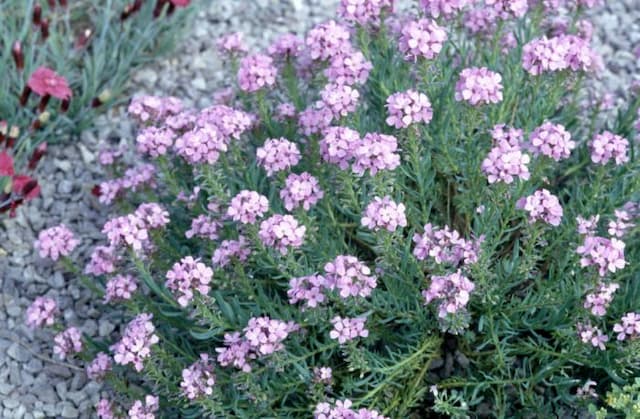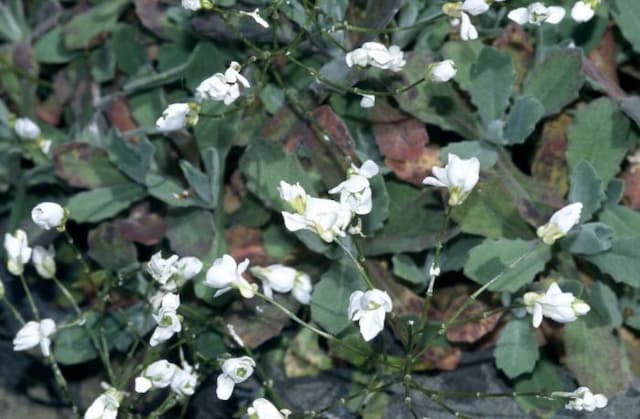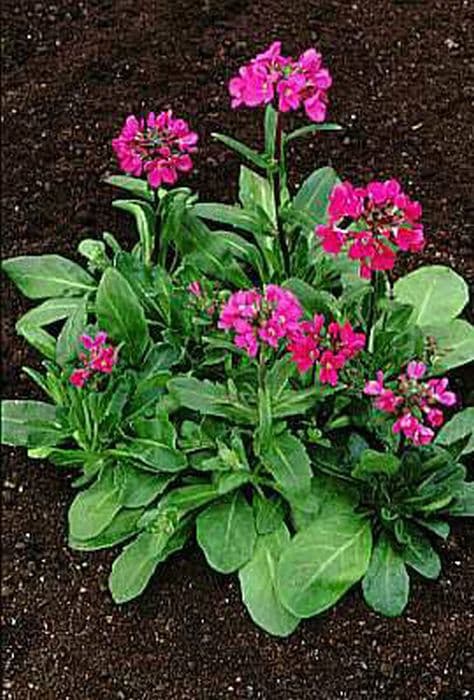Aubrieta [Axcent Burgundy] Aubrieta Axcent Burgundy (Axcent Series)
![aubrieta [Axcent Burgundy]](/_next/image?url=https%3A%2F%2Fplants-admin.emdemapps.com%2Fimages%2Fplants%2F%2Fimages%2F604b5b7b548d8.png&w=3840&q=75)
ABOUT
[Axcent Burgundy] is a compact, mat-forming, evergreen perennial to about 10cm with small, grey-green leaves and red-purple flowers from mid-spring to early summer
About this plant
 Names
NamesFamily
Brassicaceae.
Synonyms
Aubrieta, False Rockcress, Purple Rock Cress, Rainbow Rock Cress.
Common names
Aubrieta cultorum.
 Characteristics
CharacteristicsLife cycle
Perennials
Foliage type
Evergreen
Color of leaves
Green
Flower color
Burgundy
Height
4 inches (10 cm)
Spread
18 inches (45 cm)
Plant type
Herb
Hardiness zones
4
Native area
Southeastern Europe
Benefits
 General Benefits
General Benefits- Easy to grow: Aubrieta is known for being low maintenance and easy to care for, making it ideal for gardeners of all skill levels.
- Drought-tolerant: Once established, it requires minimal watering, which is beneficial in areas prone to drought or for water-wise gardens.
- Ground cover: Its mat-forming growth habit makes it excellent for covering bare spots, controlling erosion, and suppressing weeds.
- Attracts pollinators: Flowers of Aubrieta attract bees and butterflies, which are essential for the pollination of plants and the overall health of the garden.
- Spring blooming: It produces vibrant flowers early in the spring, adding color to the garden when many other plants are not yet in bloom.
- Rock gardens: Aubrieta is suited for rock gardens or alpine settings, where it can cascade beautifully over rocks and walls.
- Border plant: Its compact size and lush flowering make it an attractive choice for borders and edging.
- Container gardening: Suitable for growing in containers where its trailing habit can be showcased on balconies and patios.
- Deer resistant: Typically not favored by deer, which is an advantage in areas where deer browsing can be a problem for garden plants.
- Perennial growth: As a perennial, it will return year after year, which is cost-effective and provides consistency in landscaping.
 Medical Properties
Medical PropertiesThis plant is not used for medical purposes.
 Air-purifying Qualities
Air-purifying QualitiesThis plant is not specifically known for air purifying qualities.
 Other Uses
Other Uses- Photography: Aubrieta can serve as an attractive ground cover, providing a vibrant burgundy backdrop for photographers interested in nature and macro photography.
- Dye Production: The richly colored leaves and petals may be used as a natural dye for fabrics or artwork.
- Culinary Garnish: Although not commonly consumed, the flowers can be used to add a splash of color as an edible garnish for salads and desserts.
- Art Supplies: Pressed Aubrieta flowers can be used in creating botanical art or for adding natural elements to papermaking and scrapbooking.
- Education: This plant can be used in educational settings, such as in biology classrooms, to help students learn about plant biology and taxonomy.
- Theme Gardens: Aubrieta works well in fairy or miniature gardens due to their small size and dense floral coverage.
- Festive Decorations: The bright burgundy flowers can be incorporated into wreaths and floral arrangements for seasonal or festive decorations.
- Nature Crafts: Children can use the flowers and leaves in nature crafts, such as creating a natural collage or pressed flower bookmarks.
- Live Jewelry: Delicate Aubrieta blossoms can be fashioned into living jewelry, such as bracelets or hair accessories, for special occasions.
- Soil Erosion Control: When planted on slopes or areas prone to erosion, Aubrieta can help stabilize the soil with its extensive root system.
Interesting Facts
 Feng Shui
Feng ShuiThe plant Aubrieta is not used in Feng Shui practice.
 Zodiac Sign Compitability
Zodiac Sign CompitabilityThe plant Aubrieta is not used in astrology practice.
 Plant Symbolism
Plant Symbolism- Determination: The Aubrieta, also known as rock cress, is a resilient plant often found on rocky slopes, symbolizing determination to overcome challenging environments.
- Survival: Its ability to survive in poor soil conditions and harsh terrains reflects the symbolic meaning of survival and adaptation.
- Beauty in harshness: The vibrant burgundy flowers of the Aubrieta Axcent Burgundy against the tough rocks convey beauty and grace even in the harshest circumstances.
- Grounding: As a ground-cover plant, rock cress symbolizes staying grounded, humility, and maintaining a low profile.
 Water
WaterRock Cress requires moderate watering, especially during the initial growth phase after planting. Once established, it is drought-tolerant and should be watered when the top inch of soil feels dry to the touch. A good approach is to water deeply but infrequently to encourage strong root growth. Water the plant with approximately one gallon of water every 7 to 10 days, adjusting for climate conditions, with less frequent watering needed during rainy periods or in cooler temperatures.
 Light
LightRock Cress thrives in full sun to partial shade. The ideal location would offer at least six hours of direct sunlight daily. When grown in too much shade, Rock Cress may produce fewer flowers and become leggy, so it's best to plant it in a spot where it can bask in plenty of light.
 Temperature
TemperatureRock Cress is hardy and can tolerate a range of temperatures but performs best in temperatures between 60°F and 75°F. This plant can survive cold temperatures down to around 20°F and is generally tolerant of heat provided it isn't excessively humid. Consistent temperatures outside of this range may inhibit flowering and overall vitality.
 Pruning
PruningPrune Rock Cress to maintain its shape and encourage denser growth. Typically, pruning is done immediately after the flowering season to remove spent blooms and any leggy stems. Cutting back the plant by one-third every year in early spring can help to rejuvenate it and promote more vigorous flowering.
 Cleaning
CleaningAs needed
 Soil
SoilThe best soil mix for Rock Cress (Aubrieta) is well-draining with a balance of loamy and sandy components. A slightly alkaline pH between 6.5 to 7.5 is ideal.
 Repotting
RepottingRock Cress rarely needs repotting as it prefers to be undisturbed. If necessary, repotting can be done every 3 to 4 years or when it outgrows its container.
 Humidity & Misting
Humidity & MistingRock Cress thrives in average to low humidity conditions and does not require high humidity levels to grow well.
 Suitable locations
Suitable locationsIndoor
Provide bright light, cool temps, minimal watering.
Outdoor
Full sun, well-drained soil, water when dry.
Hardiness zone
4-9 USDA
 Life cycle
Life cycleAubrieta Axcent Burgundy, commonly known as "Rock Cress," begins its life as a seed, which, when sown, germinates within one to three weeks at optimal temperatures between 15-20°C (59-68°F). After germination, the seedling develops into a mat-forming perennial with small, rounded leaves. During its vegetative stage, Rock Cress establishes a dense mat of foliage that is drought tolerant once established. It enters the flowering stage in early spring, producing vibrant burgundy blooms that attract pollinators and provide a ground cover. After flowering, the plant sets seed, which can self-sow to propagate new plants. In the final stage of its life cycle, Rock Cress may experience senescence after several years, at which point it can be rejuvenated by dividing and replanting vigorous sections.
 Propogation
PropogationPropogation time
Spring
The most popular method of propagating Aubrieta Axcent Burgundy, known commonly as Rock Cress, is by stem cuttings. This is best done in late spring or early summer when the plant's growth is vigorous. Select a healthy, non-flowering shoot and cut a 3 to 4 inch (approximately 7.5 to 10 cm) section, making sure to include at least two sets of leaves. Remove the bottom leaves and dip the cut end into rooting hormone powder to encourage root growth. Plant the cutting in a well-draining soil mix, ensuring that the leaf nodes where bottom leaves were removed are buried. Keep the soil moist but not waterlogged, and provide a warm environment with indirect light. Roots typically develop within a few weeks, after which the cuttings can be transplanted to their final location.









